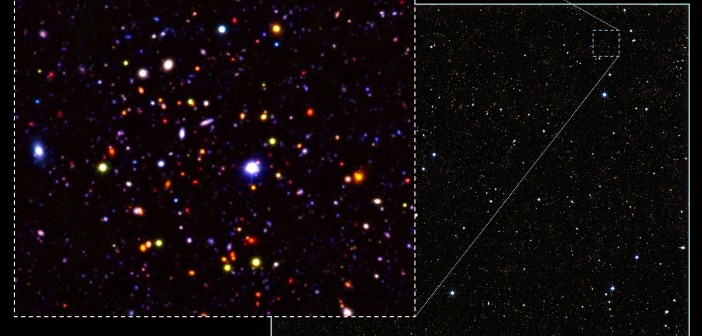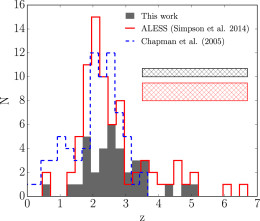Submillimeter galaxies — i.e., galaxies that we detect in the submillimeter wavelength range — are mysterious creatures. It’s only within the last couple decades that we’ve had telescope technology capable of observing them, and we’re only now getting to the point where angular resolution limits allow us to examine them closely. A new study has taken advantage of new capabilities to explore the properties of a sample of 52 of these galaxies.
Dusty Star Formation
Submillimeter galaxies are generally observed in the early universe. Though they’re faint in other wavebands, they’re extremely luminous in infrared and submillimeter — their infrared luminosities are typically trillions of times the Sun’s luminosity. This is thought to be because these galaxies are very actively forming stars at rates of hundreds of times that of the Milky Way!

Example 10” × 10” true-color images of ten submillimeter galaxies in the authors’ ALMA-identified sample. [Simpson et al. 2017]
Why look for submillimeter galaxies? Studying them can help us to learn about galaxy and star formation early in our universe’s history, and help us to understand how the universe has evolved into what we see locally today.
Submillimeter Struggles
Due to angular resolution limitations in the past, we often couldn’t pin down the exact locations of submillimeter galaxies, preventing us from examining them properly. But now a team of scientists has used the Atacama Large Millimeter/submillimeter array (ALMA) to precisely locate 52 submillimeter galaxies identified by the Submillimeter Common-User Bolometer Array (SCUBA-2) in the UKIDSS Ultra Deep Survey field.
The precise locations made possible by ALMA allowed the team — led by James Simpson (University of Edinburgh and Durham University) — to identify the multi-wavelength properties of these galaxies in a pilot study that they hope to extend to many more similar galaxies in the future.
Lessons from Distant Galaxies
What did Simpson and collaborators learn in this study?
- For the set of galaxies for which the team could measure photometric redshifts, the median redshift was z ~ 2.65 (though redshifts ranged up to z ~ 5).
- Submillimeter galaxies are cooler and larger than local far-infrared galaxies (known as ULIRGs). The authors therefore argue that it’s unlikely that ULIRGs are evolved versions of submillimeter galaxies.
- Estimates of dust mass in these galaxies suggest that effectively all of the optical-to-near-infrared light from colocated stars is obscured by dust.
- Estimates of the future stellar mass of these galaxies suggest that they cannot evolve into lenticular or spiral galaxies. Instead, the authors conclude, submillimeter galaxies must be the progenitors of local elliptical galaxies.
Citation
J. M. Simpson et al 2017 ApJ 839 58. doi:10.3847/1538-4357/aa65d0



1 Comment
Pingback: Astronomy on Tap ATX #45: May 15, 2018 – Astronomy On Tap